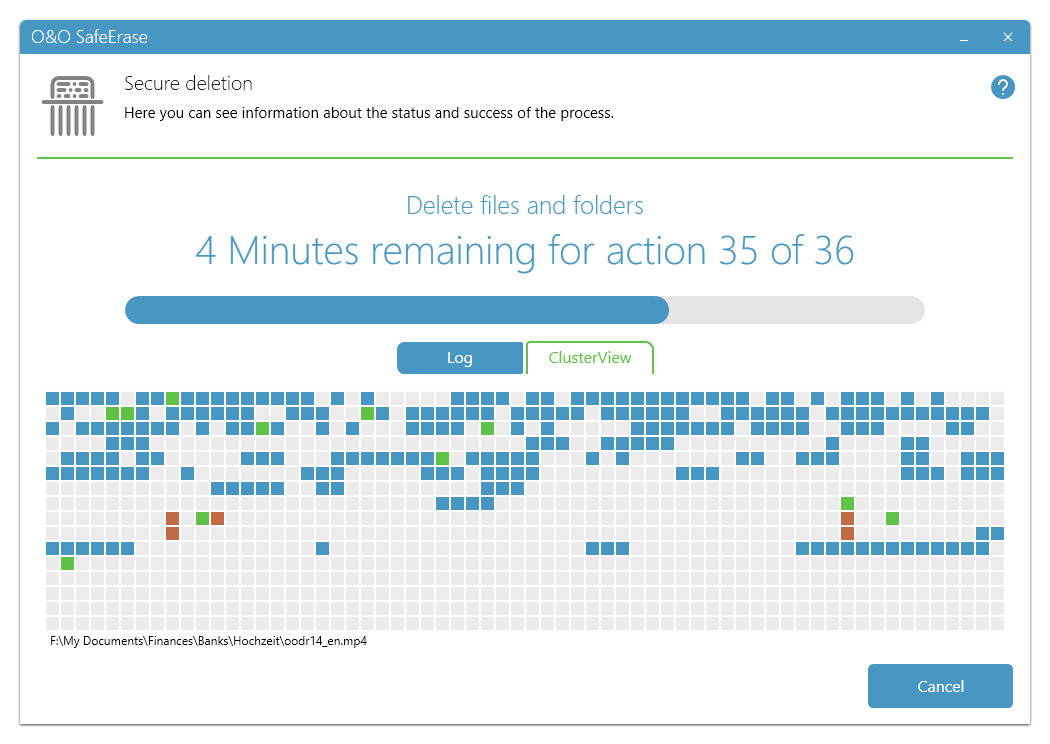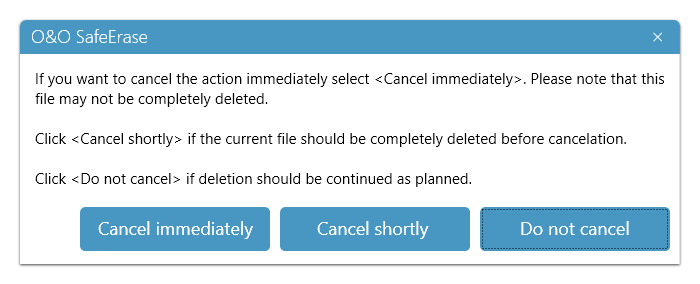ClusterView
The ClusterView shows where the data being deleted is located and charts the approximate progress of deletion. O&O SafeErase automatically displays the files or partitions being deleted along with the full stand of the partitions. The view can change depending on the items currently being deleted.
It’s not always possible to display the position and progress of very small files such as browser data because these files were either saved in the clipboard or were deleted by O&O SafeErase before the ClusterView was able to locate them. During deletion of free space, the progress of deletion on the partition will be displayed in its entirety, the subtask itself will not be visible in the ClusterView. You should also note that O&O SafeErase deletes simultaneously whenever possible, especially in the Server Edition. This can result in the ClusterView displaying parts of the deletion process only briefly.
Partial display in the ClusterView does not reflect partial completion of the deletion! The deletion itself is done by a different part of the program and is totally separate from the ClusterView. The ClusterView serves merely as a visualization of the deletion process.

ClusterView
Why could my deletion only be completed with a warning?
You may occasionally receive notification that deletion could only be completed with warnings. This means that some, but not all, elements marked for deletion were not able to be deleted.
There are various reasons why this happens. When deleting Windows and program files, some of these files may be needed by Windows itself. This is usually indicated in reports as “blocked by […]“. If this is caused by a program you opened, you can close it and then try deleting again. If it involves a system program, restarting the system can sometimes help. Most often, however, it’s just not possible to delete the data because the system will not unblock it.
The notice “Access denied“ in logs and reports involves files that may only be changed by the system. These are usually located in a folder that O&O SafeErase indentifies as containing temporary files but not all of these files are accessible.
EFS encrypted files are not supported and will therefore not be taken into account for deletion.
The same thing can occur when deleting Browser data. This is especially the case after deleting data from Edge or Internet Explorer where a notice frequently appears indicating that deletion was closed with warnings. Edge or Internet Explorer are started by Windows for internal processing in the background and some of their files are actively being used accordingly. If warnings are displayed while deleting browser data, check to make sure all browsers are closed and try again. Sometimes restarting the system is able to help.
If you selected Files, folders, or partitions for deletion and receive warnings, check to see if any files are being used, for example if Explorer is opened in one of them or if a file on a partition is being processed.
Why does deletion take so long?
Deletion can sometimes take many hours or even days to complete. This is always the case when
• Large volumes of were selected for deletion
• A deletion method with many runs was selected
• The data is located on damaged hardware
• The system is being used to capacity (during a backup or other write processes, Windows updates, etc.)
What happens if I stop deletion?
If you stop deletion you can choose among the following options

Stop deletion
If you click on Cancel, the program will ask, if you want to cancel immediately.
If you say Yes, the actual process will be stopped with some files still in restorable condition.
Should you say No, however, the last file will be completely removed and then the process will be aborted.
Clicking Cancel will resume the deletion process.
If, for example, you stop deletion while deleting a partition, you can expect some data to still be readable on the disk while other data cannot be recovered. It’s very probable that you’ll need to reformat the partition without any guarantee that the old data was securely deleted.
With system partitions, you’ll no longer be able to boot the system – not even if you stopped deletion immediately after deletion was started. Deletion, whether partial or complete, cannot be undone and as a result, the system is missing important files needed for booting.